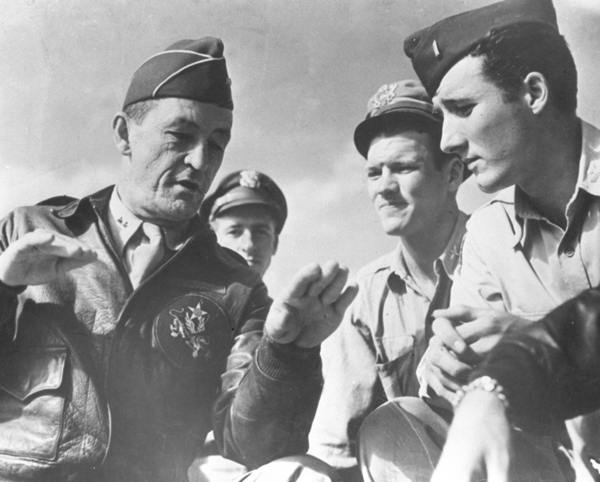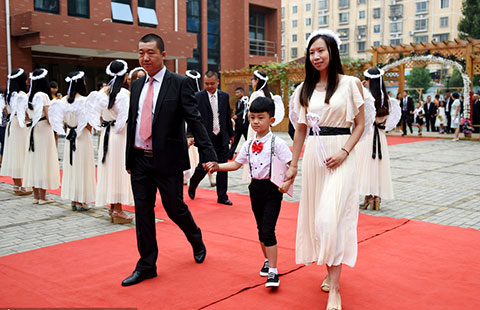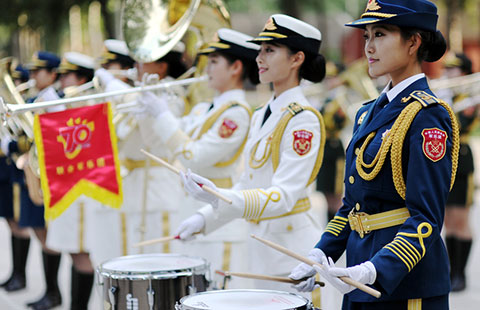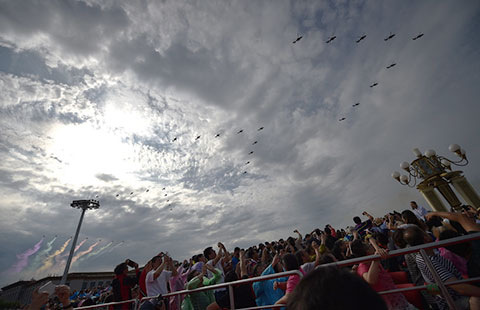Flying Tigers a symbol of friendship, then and now
Updated: 2015-09-03 00:08
By Joseph Catanzaro, Li Yang, Huang Zhiling and An Baijie(CHINA WATCH)
|
|||||||||
 |
|
Lieutenant General Claire Chennault (left), commander of the U.S. 14th Air Force, explains flying techniques to pilots at Kunming airport in Yunnan province in 1944. PHOTOS BY XINHUA |
Fighter planes roared overhead, weaving and diving in a deadly dance, filling the evening sky with the staccato cough of machine-gun fire. It was 1944, and the Japanese air force all but ruled the skies over battle-scarred China.
Long Fenggao was 9 years old the day he watched the warplanes clash over Yangtang, near the southern city of Guilin. He had lost his mother to a Japanese germ bomb four years earlier, and he would soon be orphaned when another raid would kill his father.
But on that day, his salvation came in the form of a squadron of outgunned Curtiss P-40 Warhawks, their noses painted to resemble gaping shark jaws.
The Flying Tigers, originally the 1st American Volunteer Group, entered the war in early 1941 and, for a time, were the only thing that stood between the Japanese and total aerial supremacy over China.
In the skies over Yangtang, Long said he saw a sliver of hope. And hours later, when villagers found an injured American pilot in a rice field, he repaid that hope in spades, traveling with a group through the night to return the airman safely to an Allied base. Long guided the way through the darkness with an oil lamp.
“All my family died in the Japanese bombings,” said the 81-year-old. “The Flying Tigers helped me to take revenge. I regard their families as my family. I’m honored to have helped save that injured U.S. pilot, even though I never knew his name.”
The Flying Tigers, led by retired U.S. Army Air Corps officer Claire Lee Chennault, was set up in Burma (now Myanmar) with 100 outdated Warhawks and 99 American pilots and ground crew who had all resigned commissions in the military. The squadron later flew from three purpose-built airstrips in Guilin.
Using Chennault’s unorthodox tactics, which involved attacking in pairs and making diving passes at the enemy, the squadron destroyed almost 300 Japanese aircraft, losing only 12 of their own.
Although technically a mercenary outfit, historians believe the U.S. government unofficially sanctioned the Flying Tigers before war was declared on Japan in December 1941.
On July 4, 1942, the squadron was disbanded and replaced by the 23rd Fighter Group of the U.S. Army Air Forces, later absorbed into the 14th Air Force, under the command of the reinstated Lieutenant General Chennault.
According to historian Ge Shuya, by 1941, China’s fledgling air force had been all but destroyed. The Flying Tigers, which later expanded to a force of about 3,000 planes, helped turn the tide. “For (one period of) 199 days, Japan’s 2,452 aircraft bombed one city (Kunming in Yunnan province) 465 times,” he said. “The arrival of the Flying Tigers changed the situation.”
The American airmen went on to destroy more than 2,500 enemy aircraft, sink or cripple 45 naval ships and 2.23 million metric tons worth of enemy merchant vessels, and kill more than 66,700 enemy troops.

 Red carpet ceremony for first grade kids
Red carpet ceremony for first grade kids
 Kashgar old city in Xinjiang is well preserved
Kashgar old city in Xinjiang is well preserved
 Infographic: Symbols behind numbers
Infographic: Symbols behind numbers
 Beijing's preparations begin long before the parade starts
Beijing's preparations begin long before the parade starts
 Female soldiers of military band practice for the V-Day parade
Female soldiers of military band practice for the V-Day parade
 Robotic exhibition set to kick off in Shenyang
Robotic exhibition set to kick off in Shenyang
 Eat from a paper hotpot
Eat from a paper hotpot
 8 interesting facts about the upcoming V-day Parade
8 interesting facts about the upcoming V-day Parade
Most Viewed
Editor's Picks

|

|

|

|

|

|
Today's Top News
Peking Opera: Star power
IMF: China can transition
Xi urges cross-Straits honoring of history
Xi awards medals to veterans
Stocks sell off on growth fears
China and US working closely on every major issue: Envoy
PLA to showcase top weapons for the first time in parade
Senior US official to visit China on bilateral issues
US Weekly

|

|








